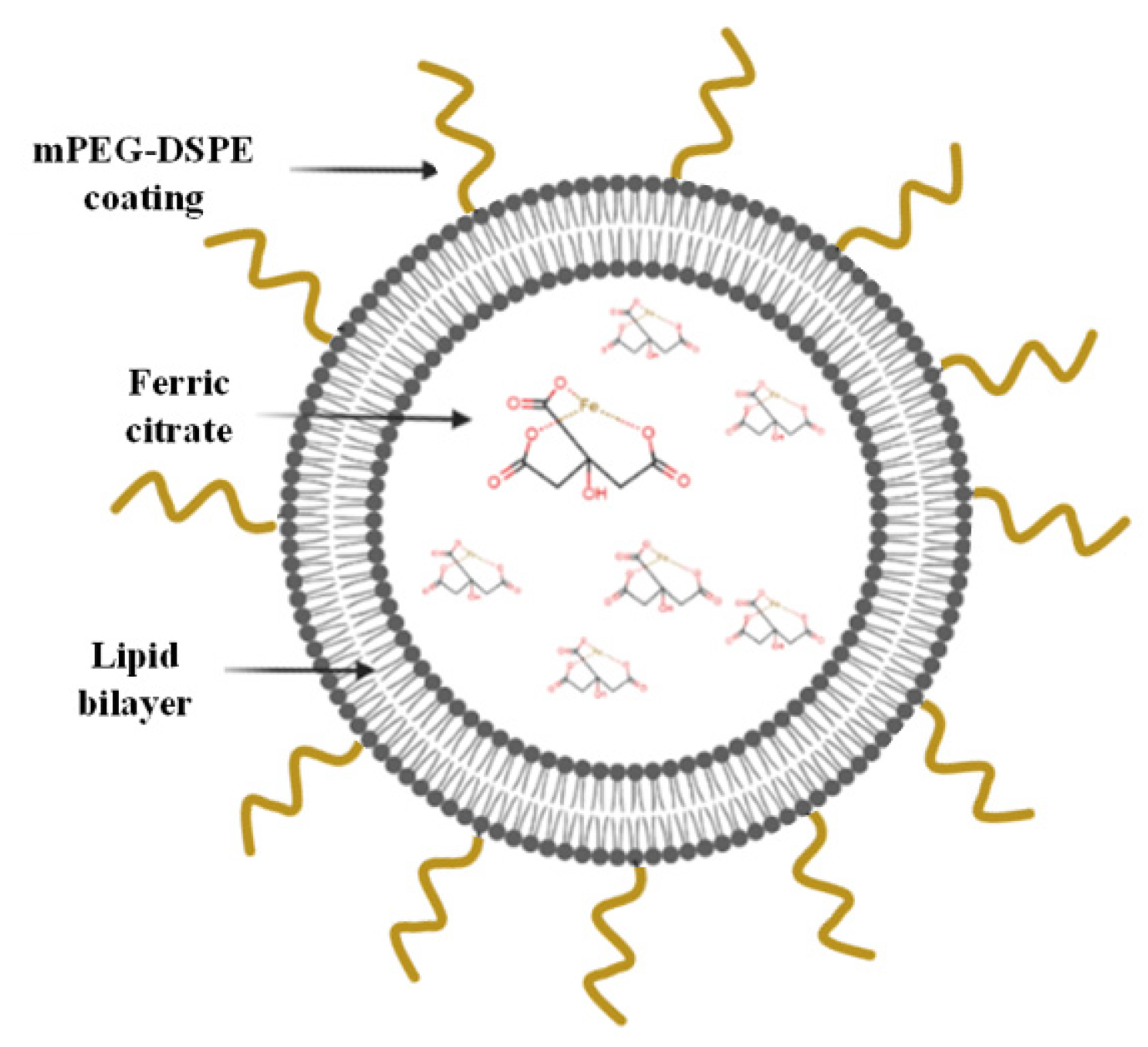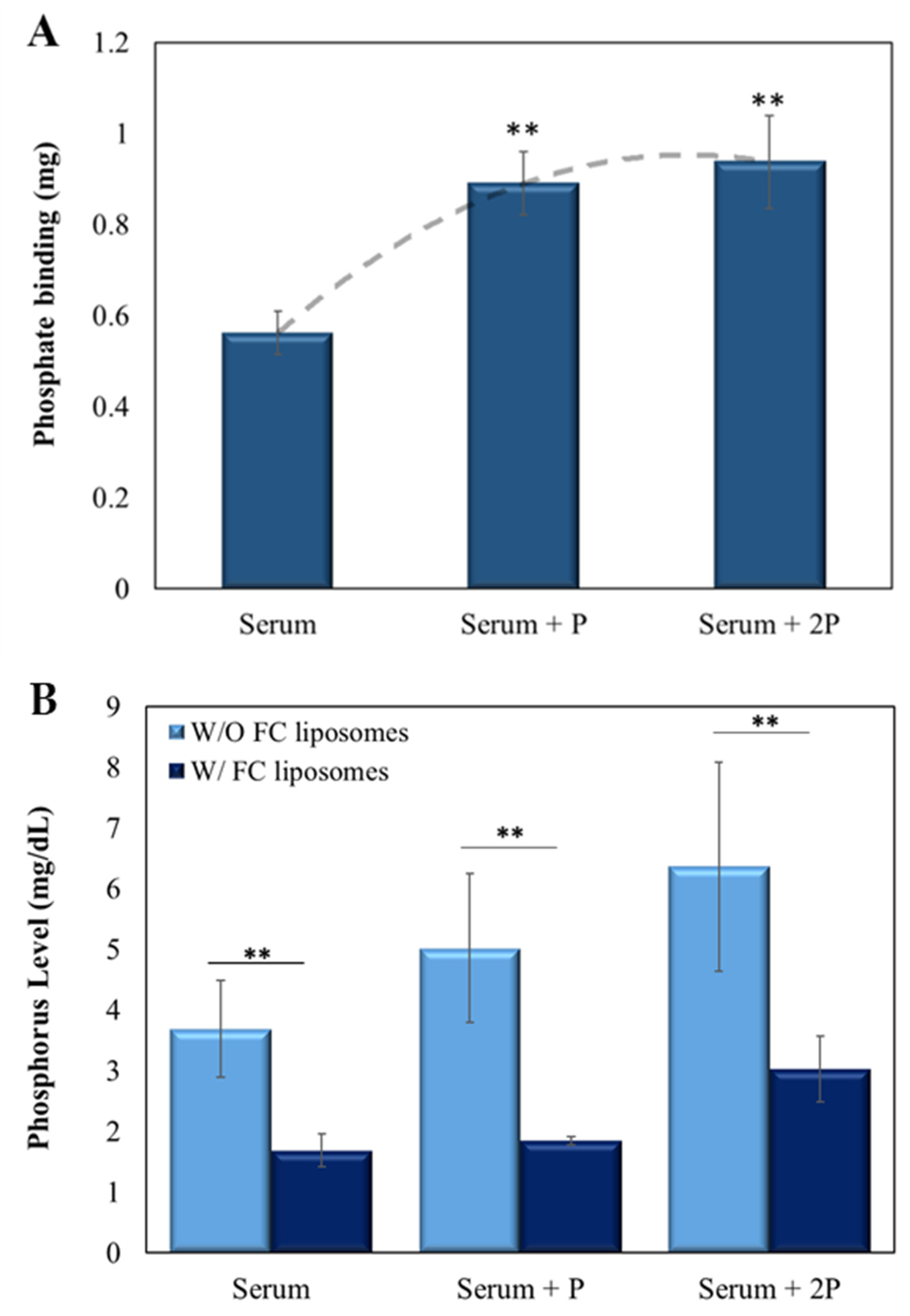Phosphate-Trapping Liposomes for Long-Term Management of Hyperphosphatemia
Abstract
:1. Introduction
2. Materials and Methods
2.1. Liposome Synthesis
2.2. Incubation of Liposomes with Phosphate Solutions
2.3. TLC Analysis
2.4. Analysis of Serum Treated with FC Liposomes
2.5. Statistical Analysis
3. Results and Discussion
3.1. Synthesis and Characterization of FC Liposomes
3.2. FC Liposomes Trap Free Phosphate Ions from Solution
3.3. FC Liposomes Reduce Serum Phosphate Levels
3.4. FC Liposomes Uptake Phosphate from Serum over Time
4. Conclusions
Supplementary Materials
Author Contributions
Funding
Institutional Review Board Statement
Informed Consent Statement
Data Availability Statement
Conflicts of Interest
References
- Yagil, Y.; Fadem, S.Z.; Kant, K.S.; Bhatt, U.; Sika, M.; Lewis, J.B.; Negoi, D.; for the Collaborative Study Group. Managing hyperphosphatemia in patients with chronic kidney disease on dialysis with ferric citrate: Latest evidence and clinical usefulness. Ther. Adv. Chronic Dis. 2015, 6, 252–263. [Google Scholar] [CrossRef] [PubMed] [Green Version]
- Pohlmeier, R.; Vienken, J. Phosphate removal and hemodialysis conditions. Kidney Int. Suppl. 2001, 59, S190–S194. [Google Scholar] [CrossRef] [PubMed] [Green Version]
- Waheed, A.A.; Pedraza, F.; Lenz, O.; Isakova, T. Phosphate control in end-stage renal disease: Barriers and opportunities. Nephrol. Dial. Transplant. 2013, 28, 2961–2968. [Google Scholar] [CrossRef] [Green Version]
- Cupisti, A.; Kalantar-Zadeh, K. Management of Natural and Added Dietary Phosphorus Burden in Kidney Disease. Semin. Nephrol. 2013, 33, 180–190. [Google Scholar] [CrossRef] [Green Version]
- Elias, R.M.; Alvares, V.R.; Moysés, R.M. Phosphate Removal during Conventional Hemodialysis: A Decades-Old Misconception. Kidney Blood Press. Res. 2018, 43, 110–114. [Google Scholar] [CrossRef] [PubMed]
- Farrand, K.F.; Copley, J.B.; Heise, J.; Fridman, M.; Keith, M.S.; Poole, L. Analysis of serum phosphate control and phosphate binder utilization in incident he-modialysis patients. Int. J. Nephrol. Renovasc. Dis. 2014, 7, 261–269. [Google Scholar]
- Block, G.A. Ferric Citrate in Patients with Chronic Kidney Disease. Semin. Nephrol. 2016, 36, 130–135. [Google Scholar] [CrossRef]
- Haas, T.; Hillion, D.; Dongradi, G. Phosphate kinetics in dialysis patients. Nephrol. Dial. Transplant. 1991, 6, 108–113. [Google Scholar]
- Shaman, A.M.; Kowalski, S.R. Hyperphosphatemia Management in Patients with Chronic Kidney Disease. Saudi Pharm. J. 2015, 24, 494–505. [Google Scholar] [CrossRef] [Green Version]
- Lemoine, S.; Fournier, T.; Kocevar, G.; Belloi, A.; Normand, G.; Ibarrola, D.; Sappey-Marinier, D.; Juillard, L. Intracellular phosphate dynamics in muscle measured by magnetic resonance spec-troscopy during hemodialysis. J. Am. Soc. Nephrol. 2016, 27, 2062–2068. [Google Scholar] [CrossRef] [Green Version]
- Minutolo, R.; Bellizzi, V.; Cioffi, M.; Iodice, C.; Giannattasio, P.; Andreucci, M.; Terracciano, V.; Di Iorio, B.R.; Conte, G.; De Nicola, L. Postdialytic Rebound of Serum Phosphorus: Pathogenetic and Clinical Insights. J. Am. Soc. Nephrol. 2002, 13, 1046–1054. [Google Scholar] [CrossRef] [PubMed]
- Pennoyer, A.; Bridgeman, M.B. Ferric citrate (auryxia) for the treatment of hyperphosphatemia. Pharm. Ther. 2015, 40, 329–339. [Google Scholar]
- Covic, A.; Rastogi, A. Hyperphosphatemia in patients with ESRD: Assessing the current evidence linking outcomes with treatment adherence. BMC Nephrol. 2013, 14, 153. [Google Scholar] [CrossRef] [PubMed]
- Chan, S.; Au, K.; Francis, R.S.; Mudge, D.W.; Johnson, D.W.; Pillans, P.I. Phosphate binders in patients with chronic kidney disease. Aust. Prescr. 2017, 40, 10–14. [Google Scholar] [CrossRef] [PubMed] [Green Version]
- Gray, K.; Ficociello, L.H.; Hunt, A.E.; Mullon, C.; Brunelli, S.M. Phosphate binder pill burden, adherence, and serum phosphorus control among he-modialysis patients converting to sucroferric oxyhydroxide. Int. J. Nephrol. Renovasc. Dis. 2019, 12, 1–8. [Google Scholar] [CrossRef] [PubMed] [Green Version]
- Forfang, D.; Edwards, D.P.; Kalantar-Zadeh, K. The Impact of Phosphorus Management Today on Quality of Life: Patient Per-spectives. Kidney Med. 2022, 4, 100437. [Google Scholar] [CrossRef]
- Barenholz, Y. Doxil®—The first FDA-approved nano-drug: Lessons learned. J. Control. Release 2012, 160, 117–134. [Google Scholar] [CrossRef]
- Gabizon, A.A. Liposome circulation time and tumor targeting: Implications for cancer chemotherapy. Adv. Drug Deliv. Rev. 1995, 16, 285–294. [Google Scholar] [CrossRef]
- Tzror-Azankot, C.; Betzer, O.; Sadan, T.; Motiei, M.; Rahimipour, S.; Atkins, A.; Popovtzer, A.; Popovtzer, R. Glucose-Functionalized Liposomes for Reducing False Positives in Cancer Diagnosis. ACS Nano 2020, 15, 1301–1309. [Google Scholar] [CrossRef]
- Tzror-Azankot, C.; Sadan, T.; Atkins, A.; Motiei, M.; Popovtzer, R. Preferential uptake of glucose-functionalized liposomes by cancer cells. In Nanoscale Imaging, Sensing, and Actuation for Biomedical Applications XIX; SPIE: San Francisco, CA, USA, 2022; Volume 11976, pp. 56–63. [Google Scholar] [CrossRef]
- Gabizon, A.; Shmeeda, H.; Barenholz, Y. Pharmacokinetics of pegylated liposomal doxorubicin: Review of animal and human studies. Clin. Pharmacokinet. 2003, 42, 419–436. [Google Scholar] [CrossRef]
- Sinsakul, M.; Sika, M.; Koury, M.; Shapiro, W.; Greene, T.; Dwyer, J.; Smith, M.; Korbet, S.; Lewis, J. The Safety and Tolerability of Ferric Citrate as a Phosphate Binder in Dialysis Patients. Nephron Exp. Nephrol. 2012, 121, c25–c29. [Google Scholar] [CrossRef]
- Hanudel, M.R.; Laster, M.; Ramos, G.; Gales, B.; Salusky, I.B. Clinical experience with the use of ferric citrate as a phosphate binder in pediatric dialysis patients. Pediatr. Nephrol. 2018, 33, 2137–2142. [Google Scholar] [CrossRef] [PubMed]
- Berger, N.; Sachse, A.; Bender, J. Filter extrusion of liposomes using different devices: Comparison of liposome size, encapsulation efficiency, and process characteristics. Int. J. Pharm. 2001, 223, 55–68. [Google Scholar] [CrossRef]
- Silva, A.M.N.; Kong, X.; Parkin, M.C.; Cammack, R.; Hider, R.C. Iron(iii) citrate speciation in aqueous solution. Dalton Trans. 2009, 40, 8616–8625. [Google Scholar] [CrossRef]
- Sivan, S.; Schroeder, A.; Verberne, G.; Merkher, Y.; Diminsky, D.; Priev, A.; Maroudas, A.; Halperin, G.; Nitzan, D.; Etsion, I.; et al. Liposomes Act as Effective Biolubricants for Friction Reduction in Human Synovial Joints. Langmuir 2009, 26, 1107–1116. [Google Scholar] [CrossRef] [PubMed]
- Schroeder, A.; Avnir, Y.; Weisman, S.; Najajreh, Y.; Gabizon, A.; Talmon, Y.; Kost, J.; Barenholz, Y. Controlling Liposomal Drug Release with Low Frequency Ultrasound: Mechanism and Feasibility. Langmuir 2007, 23, 4019–4025. [Google Scholar] [CrossRef]
- Eknoyan, G.; Levin, A.; Levin, N.W. Bone metabolism and disease in chronic kidney disease. Am. J. Kidney Dis. 2003, 42, 1–201. [Google Scholar] [CrossRef]
- Yuan, L.; Ji, X.; Chen, J.; Xie, M.; Geng, L.; Gao, R. Enhanced oral bioavailability and tissue distribution of ferric citrate through liposomal encapsulation. CyTA-J. Food 2016, 15, 136–142. [Google Scholar] [CrossRef] [Green Version]
- Wang, S.; Li, W.; Sun, K.; Zhang, R.; Wang, S.; Geng, L. Study of release kinetics and degradation thermodynamics of ferric citrate liposomes. Chem. Phys. Lipids 2019, 225, 104811. [Google Scholar] [CrossRef]
- Hart, K.; Harvey, M.; Tang, M.; Wu, Z.; Cave, G. Liposomes to Augment Dialysis in Preclinical Models: A Structured Review. Pharmaceutics 2021, 13, 395. [Google Scholar] [CrossRef]
- Sercombe, L.; Veerati, T.; Moheimani, F.; Wu, S.Y.; Sood, A.K.; Hua, S. Advances and Challenges of Liposome Assisted Drug Delivery. Front. Pharmacol. 2015, 6, 286. [Google Scholar] [CrossRef] [PubMed] [Green Version]
- Bourquin, J.; Milosevic, A.; Hauser, D.; Lehner, R.; Blank, F.; Fink, A.; Rothen-Rutishauser, B. Biodistribution, Clearance, and Long-Term Fate of Clinically Relevant Nanomaterials. Adv. Mater. 2018, 30, e1704307. [Google Scholar] [CrossRef] [PubMed]
- Zhang, Y.-N.; Poon, W.; Tavares, A.J.; McGilvray, I.D.; Chan, W.C.W. Nanoparticle–liver interactions: Cellular uptake and hepatobiliary elimination. J. Control. Release 2016, 240, 332–348. [Google Scholar] [CrossRef]
- Shobeiri, N.; Adams, M.A.; Holden, R.M. Vascular Calcification in Animal Models of CKD: A Review. Am. J. Nephrol. 2010, 31, 471–481. Available online: https://pubmed.ncbi.nlm.nih.gov/20413965/ (accessed on 8 September 2022). [CrossRef] [PubMed]






Publisher’s Note: MDPI stays neutral with regard to jurisdictional claims in published maps and institutional affiliations. |
© 2022 by the authors. Licensee MDPI, Basel, Switzerland. This article is an open access article distributed under the terms and conditions of the Creative Commons Attribution (CC BY) license (https://creativecommons.org/licenses/by/4.0/).
Share and Cite
Tzror-Azankot, C.; Anaki, A.; Sadan, T.; Motiei, M.; Popovtzer, R. Phosphate-Trapping Liposomes for Long-Term Management of Hyperphosphatemia. Materials 2022, 15, 7779. https://doi.org/10.3390/ma15217779
Tzror-Azankot C, Anaki A, Sadan T, Motiei M, Popovtzer R. Phosphate-Trapping Liposomes for Long-Term Management of Hyperphosphatemia. Materials. 2022; 15(21):7779. https://doi.org/10.3390/ma15217779
Chicago/Turabian StyleTzror-Azankot, Chen, Adi Anaki, Tamar Sadan, Menachem Motiei, and Rachela Popovtzer. 2022. "Phosphate-Trapping Liposomes for Long-Term Management of Hyperphosphatemia" Materials 15, no. 21: 7779. https://doi.org/10.3390/ma15217779




